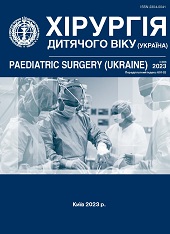Gastrointestinal bleeding in children: diagnosis, analysis, and structure
DOI:
https://doi.org/10.15574/PS.2023.80.59Keywords:
gastrointestinal bleeding (GIB), pediatric surgery, esophagogastroduodenoscopyAbstract
The incidence of gastrointestinal bleeding is a significant concern among adult patients with gastrointestinal tract (GIT) disorders, as it is a leading cause of mortality. However, there is growing evidence of changes in the pattern of gastrointestinal pathologies among children, primarily attributed to an increasing number of cases related to peptic ulcer disease (PUD) and erosive processes of the GIT.
Purpose - to investigate the prevalence and analyze changes in the structure of GIT diseases in children complicated by upper gastrointestinal bleeding (GIB), based on esophagogastroduodenoscopy (EGD) data.
Materials and methods. Based on the clinic’s records, a total of 4,457 children underwent EGD at the Regional Medical Center of Family Health in Dnipro. Among them, 1,393 (31.25%) patients were admitted to the surgical department with suspected GIB. In 201 (14.4%) cases, EGD was performed during active bleeding to determine its origin. The utilization of EGD during the acute phase in patients with suspected GIB is considered highly effective for both diagnosing the bleeding source and initiating early-stage treatment. The data were processed using the methods of variation statistics using the Statistica v 6.1 software package. To compare the relative indicators, the Pearson Hi-quadrat test (χ2) and the two-sided Fisher’s exact test (TCF) were used. The critical level of statistical significance (p) was accepted as <0.05.
Results. To conduct a comparative analysis of diagnosed cases of GIB, two groups of children with endoscopically confirmed GIB were formed: the Group I (n=125) representing the period of 2012-2013, and the Group II (n=201) - the period of 2020-2021. The results revealed an increase of 1.6 times in the number of patients with upper GIT diseases accompanied by bleeding in the Group II. Additionally, a significant rise in the frequency of GIT diseases, specifically erosive esophagitis, was observed. The number of patients with erosive esophagitis tripled in the Group II compared to the Group I.
Conclusions. In recent years, there has been a notable rise in GIT diseases accompanied by upper GIB. The number of such cases increased by 1.6 times, from 125 to 201 patients. Notably, there is a pronounced increase in the incidence of erosive esophagitis, particularly among children in the early and younger age groups.
The research was carried out in accordance with the principles of the Helsinki Declaration. The study protocol was approved by the Local Ethics Committee of participating institution. The informed consent of the patient was obtained for conducting the studies.
No conflict of interests was declared by the authors.
References
Attard T, Miller M, Pant C, Kumar A, Thomson M. (2017). Mortality associated with GIB in children: A retrospective cohort study. World J Gastroenterol. 23 (9): 1608. https://doi.org/10.3748/wjg.v23.i9.1608; PMid:28321162 PMCid:PMC5340813
Dihtiar VA, Sadovenko OH, Kaminska MO, Shchudro SO et al. (2016). Endoscopic examination in cases of diseases of the GIT in children. Halytskyi likarskyi visnyk. 23 (3): 104-106. URL: http://nbuv.gov.ua/UJRN/glv_2016_23_3(1)__40.
Dihtiar VA, Sushko VI, Kryvchenia DY et al. (2019). Pediatric Surgery. V.A. Dihtiar, V.I. Sushko, D.Y. Kryvcheni (eds). Vseukrainske spetsializovane vydavnytstvo "Meditsina". Ukraine: 368.
Godik OS, Voroniak DI, Kolomoiets IV, Trembach LO et al. (2020). Evaluation of the endoscopic and surgical methods of preheatic portal hypertension treatment in children. Paediatric Surgery. Ukraine. 2 (67): 29-35. https://doi.org/10.15574/PS.2020.67.29
Gralnek IM, Camus Duboc M, Garcia-Pagan JC et al. (2022). Endoscopic diagnosis and management of esophagogastric variceal hemorrhage: European Society of Gastrointestinal Endoscopy (ESGE) Guideline. Endoscopy. 54 (11): 1094-1120. https://doi.org/10.1055/a-1939-4887; PMid:36174643
Norsa L, Ferrari A, Mosca A et al. (2020). Urgent endoscopy in children: epidemiology in a large region of France. Endosc Int Open. 8 (7): E969-E973. https://doi.org/10.1055/a-1178-9408; PMid:32617400 PMCid:PMC7297613
Romano C, Oliva S, Martellossi S, Miele E, Arrigo S, Graziani MG et al. (2017). Pediatric GIB: Perspectives from the Italian Society of Pediatric Gastroenterology. World J Gastroenterol. 23 (8): 1328-1337. https://doi.org/10.3748/wjg.v23.i8.1328; PMid:28293079 PMCid:PMC5330817
Sokolnik SO. (2016). Endoscopic signs of peptic ulcer disease in children, complicated by GIB. Zdorovye rebenka. 61 (2): 29-31.
Tringali A, Thomson M, Dumonceau J, Tavares M, Tabbers M, Furlano R et al. (2016). Pediatric gastrointestinal endoscopy: European Society of Gastrointestinal Endoscopy (ESGE) and European Society for Paediatric Gastroenterology Hepatology and Nutrition (ESPGHAN) Guideline Executive summary. Endoscopy. 49 (1): 83-91. https://doi.org/10.1055/s-0034-1390974
Yabe K, Kouchi K, Takenouchi A, Matsuoka A, Kudou W, Nakata C. (2020). Current status and future challenges in the endoscopic management of non-variceal upper GIB in children. Pediatr Surg Int. 36 (12): 1451-1458. https://doi.org/10.1007/s00383-020-04755-4; PMid:33034717
Downloads
Published
Issue
Section
License
Copyright (c) 2023 Paediatric Surgery (Ukraine)

This work is licensed under a Creative Commons Attribution-NonCommercial 4.0 International License.
The policy of the Journal “PAEDIATRIC SURGERY. UKRAINE” is compatible with the vast majority of funders' of open access and self-archiving policies. The journal provides immediate open access route being convinced that everyone – not only scientists - can benefit from research results, and publishes articles exclusively under open access distribution, with a Creative Commons Attribution-Noncommercial 4.0 international license(СС BY-NC).
Authors transfer the copyright to the Journal “PAEDIATRIC SURGERY.UKRAINE” when the manuscript is accepted for publication. Authors declare that this manuscript has not been published nor is under simultaneous consideration for publication elsewhere. After publication, the articles become freely available on-line to the public.
Readers have the right to use, distribute, and reproduce articles in any medium, provided the articles and the journal are properly cited.
The use of published materials for commercial purposes is strongly prohibited.

